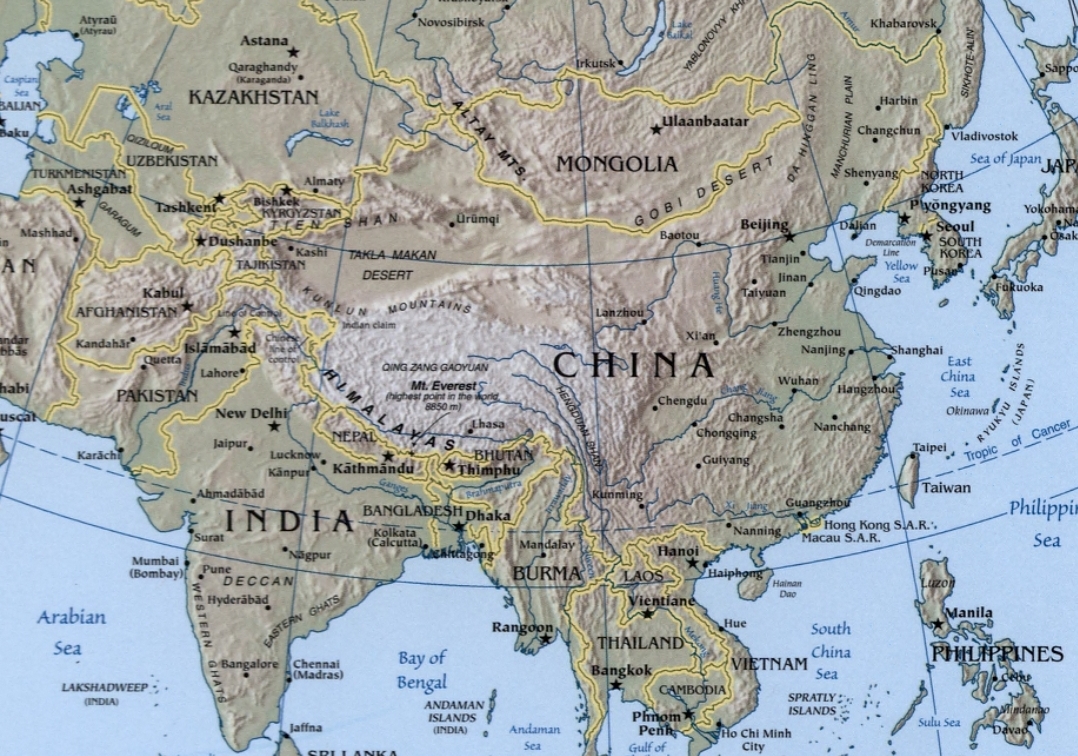
Factum Perspective: The 21st Century, an Asian Century?
By Kaif Sally
For some 500 years, the West dominated the course of history. The burning question now on the horizon is, how will the 21st century become an Asian one?
The notion of an Asian led global order is not recent. According to British economist Angus Maddison, China, India, and Japan alone had a larger total GDP than France, UK, the US, Italy, and Germany combined, for over 2000 years until the early 19th century. Changes began to unravel for Asia after World War II. Eager to recover after its defeat, Japan kickstarted its electronics and automotive sectors, propelling growth by an unprecedented average of 10 percent annually. In 1968 it became the second largest economy in the world.
Inspired by Japan’s success, South Korea, Taiwan, Hong Kong, and Singapore (the four Asian tigers) followed suit with a mix of state-guided capitalism, export-led growth, and an open-arms approach to foreign investment. Unwilling to be left behind, the ancient giants, India and China, eventually joined the growth drive, with Deng Xiaoping’s four modernizations policy during the 1970s and Narasimha Rao’s opening up of the Indian economy in 1991.
Today, Asia’s strongest claims to an “Asian Century” are its young and rapidly developing economies. However, as Henry Luce put it, “a strong economy is only one of the many requisites required to claim a century.” It was Luce who coined the term “American Century.” For him, three crucial factors contributed to this Century: the American economy, American ideals, and a sense of responsibility for leading the entire world.
This essay will examine how the 21st Century will be an Asian Century, via an analysis of her economics (Asia-nomics), her ideals (politics), and her responsibility and capability to lead the world (power). We will then examine a key challenge that Asia faces in realizing and exercising her role as the new mover of international order.
“East Asia is set to become in the next twenty years the economic centre of gravity of the world.”
Lee Kuan Yew, 1993
Lee was only partly correct. In 2020, the whole of the Asian economic zone represented 50 percent of the global GDP and two-thirds of global economic growth. Asia embodies the words “economic centre of gravity”, producing, importing, and consuming more goods than any other region (Asian Development Bank, 2015).
In 1950 the American and European share of the world GDP was 43 percent. By 2050, it will have shrunk to 24. Doubtless, a considerable portion of this decrease will be swallowed up by Asia. Rising economies like Vietnam and the Philippines will contribute to this change. Asian countries like China, South Korea, India, and Japan that once depended on industry, low labor costs, and global value chains are increasingly shifting to the service sector.
Other countries, like Malaysia, Uzbekistan, and Indonesia – which recorded the world’s highest economic growth rates in 2018 – will fill gaps left by more developed Asian economies. Professor Yuval Noah Harari, at his lecture at Google on “21 lessons for the 21st century”, reiterated that the present era will belong to nations that can run data and technology-driven economies. On this front, Asia is emerging as the clear winner.
The Asian Digital Transformation Index 2018 ranks Singapore the highest in the world for digital technology advancement, and cites upcoming critical technologies including Fiber, 5G, and AI as solely Asian strengths. For example, China is the recognized global leader in 5G technology and the largest investor in Blockchain, cryptocurrency, and 3D printing. South Korea introduced the first 5G service in the world while Japan remains the frontrunner in robotics, and Information Technology is one of India’s largest industries.
Since 2001 Western politics and forms of government are coming under increasing scrutiny. Democratically elected leaders are being blamed for mounting debt, political polarization, culture wars, rising inequality, job loss, and spikes in terrorism within the west. In contrast, the Asian way of government – taking a more interventionist and dirigiste approach, both to the economy and to the country’s administration – is becoming more popular, most prominently observed in ASEAN nations like Malaysia and Indonesia.
Traits and factors such as meritocracy, experimentation and decisiveness have aided Chinese modernization in ways that democracy may have even hindered, at least according to scholars like Daniel Bell. At the same time, economic development vis-à-vis political reform is pushing Asians to become wealthier, better educated and more demanding. This phenomenon can be observed in West Asia vis-à-vis liberal reforms in countries like Saudi Arabia.
Political and economic cooperation within Asia is also strengthening. The growing influence and memberships of the Asian Development Bank, Shanghai Cooperation Organization, Regional Comprehensive Economic Partnership, and Asia Infrastructure Investment Bank attests to these developments. Idealist commentators point out the positive role this will play in maintaining peace and political stability. Even Africa, a rising power, regards Asia as a strong partner. From 2002 to 2012, trade between the two continents grew by 2,000 percent.
The notion of Asian power is embodied in projects like the Belt and Road Initiative, one of the most significant diplomatic projects of the 21st century. The BRI has inspired an infrastructure development war within Asia, where India, Japan, Turkey and South Korea invest in countries to counterbalance Chinese influence. A great example of this would be the railway line projects both China and Japan are running concurrently in South-East Asia. Therefore, the whole of Asia is becoming more developed, and more independent and politically powerful.
Moreover, in an era of global interdependence, “hard power” seems to be becoming somewhat though not completely irrelevant. The economic cost of physical conflict has proved too much for countries to bear. Consequently, soft and smart power have become weapons of choice for many countries. To this end, Asia has seen phenomenal development over the last decade. We can observe this in tourism, entertainment, media, religion, and culture.
Nine of the ten busiest international airline routes are in Asia. 40 percent of American overseas tourists go to China while nearly 20 percent each visit India and Japan. The Chinese diaspora is now crossing the 50 million threshold worldwide, while the Indian diaspora numbers 32 million. This has exerted a significant influence across the world. In media, Al Jazeera, Al Arabiya, CSN, and Russia TV have recorded increases in viewership year on year, and consumers around the world are tuning into Bollywood, South Korean and Japanese pop culture.
Culturally, the world is in love with an endless list of Asian practices like mindfulness, dhamma, yoga and Feng Shui. Perhaps the most interesting cultural signifier of the Asian century is the coming shift in the world’s predominant religions. Characteristic of the American and European century was the spread of Christianity and the role it played in shaping the world in the West’s image. It is undeniable, then, that when Islam, another religion born in Asia but predominantly followed by Asians becomes the most followed religion in the second half of the 21st century, it will do so with gargantuan shifts in the power dynamics of the world.
Of course, such shifts come with their own set of challenges. Here we will have to consider the single most significant challenge that can have ramifications in the long term. The issue in question is climate change and water management, identified as one of the top six most critical issues facing Asia by the Asia Foundation.
Climate projections pin global warming far beyond the 1.5 ºC danger line that had initially been identified. If that happens, Asia’s economic hotspots will be badly affected, stunting economic growth and putting an untimely end to the Asian century. Many of Asia’s densely populated coastal areas, including Jakarta, Bangkok, and Shanghai, will have to spend billions to combat rising sea levels. Singapore alone expects to spend 100 billion dollars or more.
Many of these megacities will face water shortages due to overconsumption. Cities in China’s northwest have already run out, and India’s water tables are falling low nationwide. Asia consumes more than half the world’s supply of coal and aluminum, and most of the world’s hydrocarbons, minerals and food, thus expediting the fallout from climate change.
Ultimately, the solution for these challenges lies within Asia alone. The East, we are told, advocates the unity of self and other, man and nature, while the West places the individual rather than family and community at the center. It is this philosophy that has allowed Asia to work together, put their differences aside and rapidly catch up to a world that once subjugated them. Napoleon Bonaparte reportedly said of Asia, “Let her sleep for when she wakes, she will shake the world.” This seems to be what is happening right now.
Kaif Sally is a writer turned law student based in Sri Lanka. His areas of interest include commercial and civil arbitration, international arbitration, public interest litigation, and international law.
Factum is an Asia-focused think tank on International Relations, Tech Cooperation and Strategic Communications based in Sri Lanka accessible via www.factum.lk

